Projects :: Exploiting evolutionary conservation - new insights into vertebrate junctions and tube-size control
Essentially all basic cell biological processes are conserved between Drosophila and other organisms, and many genes that play critical roles in human development and disease were first identified by genetic approaches in model organisms such as Drosophila and C. elegans. Examples include homeobox transcription factors, the hedgehog, Notch/lin-12, and wnt signaling pathways, as well as the caspases and other cell death genes. A critical part of our studies is to apply our insights into tube-size control and junctional assembly to vetebrate systems. We are currently examining the role of the Na K ATPase in the assembly of vertebrate junctions. These experiments have immediate relevance to tube-size diseases such as polycystic kidney disease which is characterized by mislocalization of specific Na K ATPase isoforms and affects -1 in 800 people. Because cells' junctions also contain proteins that mediate cell polarity and growth control, our investigations are also highly relevant to cancers, which are characterized by a loss of polarity and excessive growth.


